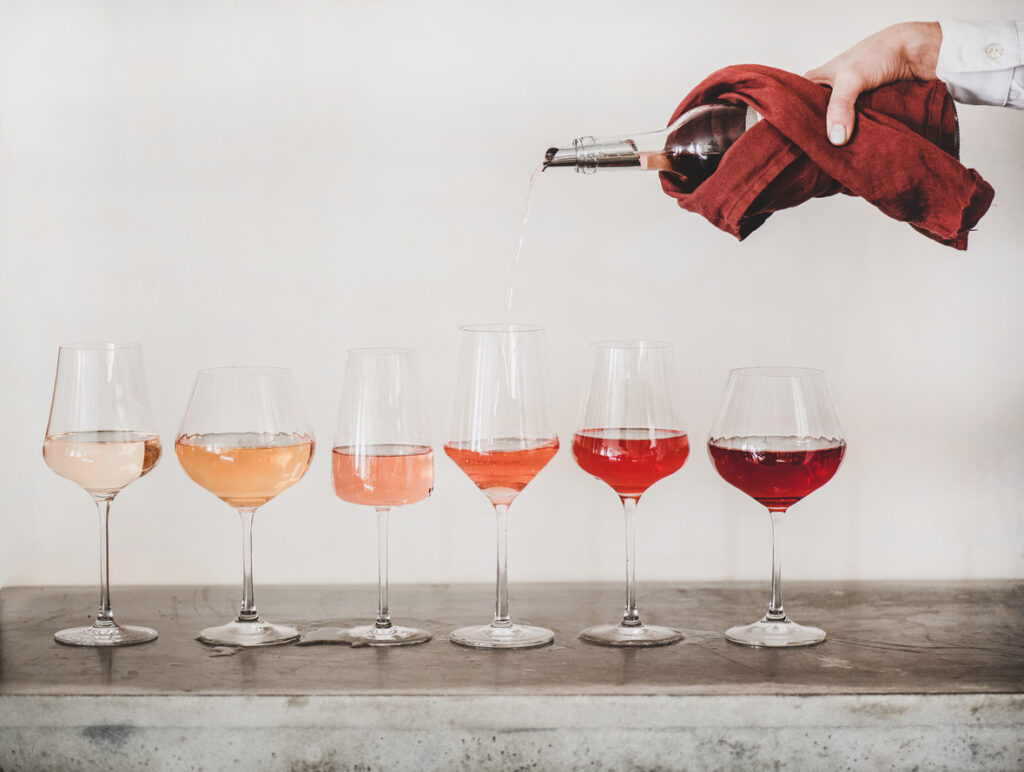When it comes to the world of wine, two popular choices, white Zinfandel and pink Moscato, often find themselves in the spotlight. With their vibrant hues and fruity notes, these wines have become synonymous with summer picnics and backyard gatherings.
However, while they may share a similar color palette, are these two varietals truly alike? In this article, we delve into the depths of winemaking to uncover the distinctive characteristics that set white Zinfandel and pink Moscato apart. So grab a glass and join us on this delightful journey as we uncork the secrets behind these beloved wines.

What is White Zinfandel
White Zinfandel, often considered a lesser-known sibling to its more renowned red counterpart, has gained a loyal following among wine enthusiasts in recent years. This pink-hued wine is made from the Zinfandel grape, known for its bold and fruity characteristics. Contrary to popular belief, white Zinfandel is not actually a white wine; it falls into the category of rosé due to its brief contact with the grape skins during fermentation.

Characteristics of White Zinfandel
One of the reasons behind white Zinfandel‘s surging popularity lies in its versatility as a food pairing companion. With its balanced acidity and soft profile, this wine pairs surprisingly well with a wide range of dishes. From spicy Thai curries to tangy barbecued chicken or even fresh seafood platters, this pink wonder can effortlessly enhance myriad flavors without overpowering them. Its fruit-forward nature often provides an interesting contrast that elevates both sweet and savory flavors on the palate.

Flavor and Aroma of White Zinfandel
While white Zinfandel has faced criticism in the past for being overly sweet or lacking complexity, contemporary producers have worked tirelessly to create more refined and nuanced offerings. Today’s top-tier white Zinfandels showcase delicate notes of strawberry and watermelon alongside hints of citrus zest, creating an intricate tapestry of flavors that linger long after each sip. The gradual shift towards producing dry-style white Zinfandels has helped elevate their status within both novice and seasoned wine drinkers—proving that there is much more than meets the eye when it comes to this captivating rosé alternative.

What is Pink Moscato
Pink Moscato is a delightful and refreshing wine that has been growing in popularity in recent years. This wine is made from the Muscat grape, which is known for its fragrant and aromatic characteristics. Unlike traditional Moscato, Pink Moscato has a beautiful pink hue due to the addition of red grapes during the winemaking process.
Pink Moscato Taste Profile
One of the reasons why Pink Moscato appeals to many wine enthusiasts is its sweeter taste profile. With its lower alcohol content and higher residual sugar levels, it offers a pleasant and fruity flavor that can be quite irresistible. Additionally, this wine often showcases notes of ripe berries, citrus fruits, and floral undertones, making it perfect for those who enjoy light and fruity beverages.

Versatility of Pink Moscato
Despite its sweet nature, Pink Moscato can also be surprisingly versatile when it comes to pairing with food. Its inherent sweetness helps balance out spicy dishes or richer flavors like roasted meats and cheeses. It can even be enjoyed as an aperitif on its own or paired with summer desserts like strawberry shortcake or fruit tarts.

Overall, Pink Moscato offers an exciting alternative to other wines on the market. From its pink color to its sweet taste with vibrant flavors, this wine has something unique to offer both casual drinkers and more serious oenophiles alike.
Pink Moscato vs. White Zinfandel
White Zinfandel and Pink Moscato are two popular wines that often get compared due to their similar pink hues, but they offer distinct flavors and characteristics. While both are sweet to taste, white Zinfandel has a more pronounced fruity flavor with hints of strawberry and watermelon, thanks to its grape variety.

On the other hand, Pink Moscato boasts a floral aroma along with citrus undertones, making it a lighter and more refreshing option.
Origin
Another key difference lies in their origin. White Zinfandel predominantly comes from California, while Pink Moscato originates from Italy’s Asti region. This variance in terroir impacts the overall taste profiles of these wines. Pairing-wise, white Zinfandel pairs harmoniously with spicy dishes like Thai curry or barbecue meats, whereas Pink Moscato complements fresh salads or light appetizers effortlessly.

Taste and Flavor
In conclusion, although white Zinfandel and Pink Moscato may share a similar rosy appearance, they possess distinct qualities when it comes to taste and origin. Ultimately, the choice between these wines depends on personal preference—a matter of whether you prefer the vibrant fruity notes of the former or the delicate floral aromatics of the latter.

Best Food with Pink Moscato and White Zinfandel
When it comes to pairing food with white Zinfandel and Pink Moscato, there are endless possibilities that will enhance the flavors of both the wine and the dish. One excellent option is to pair these light and fruity wines with a variety of cheeses. Soft cheeses like brie or camembert complement the sweetness of Pink Moscato, while bold or aged cheeses like cheddar or gorgonzola provide an interesting contrast to the fruitiness of white Zinfandel.

Seafood
Another fantastic match for these wines is seafood. The crisp acidity and delicate flavors make them perfect companions for shrimp, scallops, or grilled fish. Try serving a chilled glass of white Zinfandel alongside a plate of grilled prawns marinated in garlic and lemon juice for a refreshing burst of flavors. Similarly, you can’t go wrong pairing Pink Moscato with grilled salmon glazed with a honey-soy glaze – the sweet and savory combination will create an explosion on your taste buds.

Complementary Food Pairing
Pairing these wines with complementary foods adds an interesting element to your taste buds’ journey. White Zinfandel’s fruit-forward profile complements salads and light seafood dishes wonderfully. Its subtle sweetness counters spiciness effortlessly, making it an excellent choice for pairing with Thai or Indian cuisine. On the other hand, Pink Moscato’s sweet notes make it a great partner for desserts like strawberry shortcake or peach cobbler. Moreover, its effervescence cuts through creamy cheeses remarkably well, creating a delightful contrast in flavors.

Versatility of White Zinfandel and Pink Moscato in Food Pairing
In conclusion, when it comes to enjoying white Zinfandel and Pink Moscato wines at their best, experimenting with different food pairings is key. Whether you opt for creamy cheeses or succulent seafood dishes, these wines have the versatility to elevate any meal into an unforgettable dining experience. So why not step outside your comfort zone next time you open a bottle by trying one of these delicious combinations? Your taste buds will thank you!

How to serve White Zinfandel and Pink Moscato
To serve white Zinfandel and Pink Moscato impeccably, it is crucial to consider the ideal temperature. Both of these wines are best served chilled, as this enhances their fruity and refreshing qualities. For white Zinfandel, 9-12 degrees Celsius is recommended, while Pink Moscato should be served slightly colder at around 7-10 degrees Celsius. By adjusting the serving temperature according to these guidelines, you can accentuate the delicate flavors and aromas of these wines.

Which Glass for White Zinfandel or Pink Moscato
Presentation also plays a key role in enjoying white Zinfandel and Pink Moscato to the fullest. Opt for tall wine glasses with a narrow bowl for both varietals. The width of the opening will help capture the wine’s aroma while also allowing it to hit the right spots on your palate. Additionally, consider garnishing your glass with fresh fruits like strawberries or slices of citrus fruits to add an extra touch of visual appeal and enhance the overall drinking experience.

